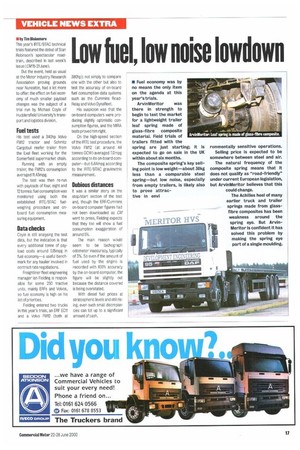VEHICLE NEWS EXTRA
Page 19

If you've noticed an error in this article please click here to report it so we can fix it.
• by Tim Makemore This year's IRTUBTAC technical trials featured the debut of Stan Robinson's spectacular roadtrain, described in last week's issue (CM15-21 June).
But the event, held as usual at the Motor Industry Research Association proving grounds near Nuneaton, had a lot more to offer: the effect on fuel economy of much smaller payload changes was the subject of a trial run by Michael Coyle of Huddersfield University's transport and logistics division.
Fuel tests
His test used a 340hp Volvo FM12 tractor and Schmitz Cargobull reefer trailer from the Exel fleet working for the Somerfield supermarket chain.
Running with an empty trailer, the FM12's consumption averaged 11.43mpg.
The test was then re-run with payloads of four, eight and 12 tonnes: fuel consumption was monitored using both the established IRTUBTAC fuelweighing procedure and onboard fuel consumption measuring equipment.
Data checks
Coyle is still analysing the test data, but the indication is that every additional tonne of payload costs around 0:15mpg in fuel economy—a useful benchmark for any haulier involved in contract rate negotiations.
Freightliner fleet engineering manager Ian Fielding is responsible for some 250 tractive units, mainly ERFs and Volvos, so fuel economy is high on his list of priorities.
Fielding entered two trucks in this year's trials, an ERF EC11 and a Volvo FM12 (both at 380hp); not simply to compare one with the other but also to test the accuracy of on-board fuel consumption data systems such as the Cummins RoadRelay and Volvo Dynafleet.
His suspicion was that the on-board computers were producing slightly optimistic consumption figures, and the MIRA tests proved him right.
On the high-speed section of the IRTE test procedure, the Volvo FM12 (at around 44 tonnes GCW) averaged 7.0mpg according to its on-board computer—but 6.64mpg according to the IRTE/BTAC gravimetric measurement.
Dubious distances
It was a similar story on the stop/start section of the test and, though the ERF/Cummins on-board computer figures had not been downloaded as CM went to press, Fielding expects that they too will show a fuel consumption exaggeration of around 5%.
The main reason would seem to be tachograph odometer inaccuracy, typically of 3%. So even if the amount of fuel used by the engine is recorded with 100% accuracy by the on-board computer, the figure will be slightly out because the distance covered is being overstated.
With diesel fuel prices at stratospheric levels and still rising, even such small discrepancies can tot up to a significant amount of cash.
















































































































